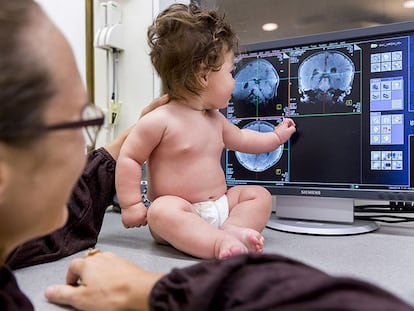Tell me how your baby cries and science will tell you what’s wrong
A study has classified newborn cries based on acoustic, neurophysiological, facial expression and body movement data. This research opens the door to using an infant’s crying as a biomarker of health

Crying is the universal language of newborns. They cry constantly to communicate their needs and feelings. In fact, they spend between one and three hours a day whimpering and sobbing. But not all crying is the same. Science has long attempted to decipher this ancestral communication system, searching for patterns and behavioral dynamics that explain what exactly each cry means. While there is still much to figure out, a new study from the Barcelona Hospital Clínic in Spain has taken a step forward in interpreting babies’ cries: the research classified the cries of healthy babies according to certain characteristics based on acoustics, behavior and neurophysiological patterns. Thus, they identified that hunger cries are constant, rhythmic and of short duration, while cries of distress are erratic and sharper. The authors say that their findings will help interpret crying in healthy infants at the household level and also have clinical potential: analysis of sobbing and the associated physiological variables may eventually function as a clinical biomarker and serve to assess an infant’s health status.
A baby’s wailing often causes confusion among parents. They sense that it is a warning sign or an unmet need, but they are not always sure of the cause or how to resolve it. “The impact on parents can range from experiences of anxiety, depression, helplessness, anger and frustration in response to infant crying, which negatively affects bonding and the parents’ perception of the infant,” the authors state in their article, published in the journal Computers in Biology and Medicine. Knowing how to interpret a newborn’s cries can be key to ensuring a baby’s well-being.
Scientists have been researching this subject for six decades. In recent years, artificial intelligence has been added to the mix for massive data analysis and increasingly reliable and accurate algorithms to analyze and interpret infant cries. “Clinical experience told you that the newborn cries differently depending on what is happening to it. And as a pediatrician you had the sense that you could learn to interpret the cries,” explains Oscar Garcia-Algar, the head of the Neonatology Department at the Clínic and the author of the study. His research was conducted in collaboration with the health technology startup Zoundream AG, which specializes in analyzing cries, and sought to test whether these perceptions were true. “What we’re trying to do here is to see if there are different crying patterns based on different variables. If the acoustic and physiological characteristics associated with crying make it possible to interpret it, this would allow us to use it in households, as well as in the healthcare context, as in an intensive care unit with babies who have some type of illness. Until now, crying had never been used to measure a clinical situation,” Garcia-Algar explains.
The Clínic researchers recruited 38 healthy newborns and took acoustic data, electroencephalogram (brain activity) data, brain oxygen saturation, facial expressions and body movements when the babies cried spontaneously. Then, using artificial intelligence systems, they analyzed and processed that data. “Beyond acoustic differences, we were able to determine associated variables, such as heart rate and body oxygenation index. We can measure and monitor them. With these parameters, the cries correspond to something specific. The studies were done on healthy babies, but now we are collecting data from premature babies and those who have some sort of illness to see if the crying patterns change,” García-Algar says.
By collecting and analyzing data from these 38 healthy infants, the authors discovered that, indeed, each cry has distinct acoustic, neurophysiological and behavioral patterns. For instance, when a baby is tired and cannot fall asleep, its cry tends to be more prolonged and monotone. On the other hand, Clínic scientists found that when a baby cries because it is hungry, the acoustic patterns are “constant, rhythmic and of short duration, intense, loud, but not high-pitched.” The authors also found patterns of increased restlessness in the babies’ electroencephalograms, as well as in physical movements, facial expressions and muscle tone. When infants are hungry, they are more restless. “In general, hunger in newborns can elicit a variety of facial expressions and body movements intended to attract caregivers’ attention, indicating a need for food, such as search reflex, sucking motions, restlessness, writhing and arching the back,” the scientists found.
Erratic crying in the face of distress
Babies also cry when they are distressed or distraught, because they are in pain or due to overstimulation that causes them discomfort. The Clínic researchers’ acoustic study reveals that in cases of distress, crying is “erratic, with fewer pauses, [it is] of prolonged duration and high-pitched.” On the other hand, the study of the brain’s electrical activity also revealed increased arousal; in terms of body patterns, in these contexts of distress and discomfort, the baby presented a “tendency to be restless,” with an increase in motor activity as an expression of high levels of discomfort, such as facial grimacing, flailing their arms and legs, arching their back, or clenching their fists.
The way babies cry when they need to burp is similar to how they cry when they are in distress but hoarser. “According to our results in cases where babies need to burp, infants with gastrointestinal problems produced longer cries (compared to those who are hungry or in distress) with more variable pitch and intensity, reflecting vocal cord instability,” the authors explain. As for oxygenation, the research identified the lowest levels in these cases as compared to the other situations studied, which the scientists argue indicates that “gastrointestinal problems, such as reflux, could interfere with proper breathing and decrease oxygen saturation levels.”
“A preliminary step” toward a future tool
The authors recognize that their research has limitations, such as the small sample size (only 38 babies) and the changes that can be caused by the electroencephalogram and brain oxygenation meter setup, which require babies to wear a cap and have a sensor on their foreheads and can cause discomfort and, therefore, produce irritated cries. Nevertheless, the researchers argue that their results represent “a preliminary step” toward developing an effective tool to analyze crying and say that measuring the neurophysiological patterns of infants’ brains and behavior adds to and confirms the acoustic data. “We also affirm the importance and potential use of a cry’s acoustics as a biomarker for assessing infant well-being,” they say.
According to García-Algar, this study’s findings are the first steps in what can be done to interpret an infant’s crying. “We are at an initial phase, analyzing the characteristics of crying and whether it corresponds to a physiological situation,” he emphasizes. And while not all the variables can be analyzed at home — for example, an electroencephalogram cannot be performed there — this research can be applied broadly: “There could be a domestic device that can interpret the cry from its acoustic characteristics. But in the clinical context, if you have a newborn baby in the hospital, you can also monitor it and interpret a crying pattern to identify, for example, whether it is hungry or what is wrong with it. Crying is a form of communication, and we can interpret what [babies] are saying. Crying can be quite valuable,” the neuroscientist says.
Sign up for our weekly newsletter to get more English-language news coverage from EL PAÍS USA Edition
Tu suscripción se está usando en otro dispositivo
¿Quieres añadir otro usuario a tu suscripción?
Si continúas leyendo en este dispositivo, no se podrá leer en el otro.
FlechaTu suscripción se está usando en otro dispositivo y solo puedes acceder a EL PAÍS desde un dispositivo a la vez.
Si quieres compartir tu cuenta, cambia tu suscripción a la modalidad Premium, así podrás añadir otro usuario. Cada uno accederá con su propia cuenta de email, lo que os permitirá personalizar vuestra experiencia en EL PAÍS.
¿Tienes una suscripción de empresa? Accede aquí para contratar más cuentas.
En el caso de no saber quién está usando tu cuenta, te recomendamos cambiar tu contraseña aquí.
Si decides continuar compartiendo tu cuenta, este mensaje se mostrará en tu dispositivo y en el de la otra persona que está usando tu cuenta de forma indefinida, afectando a tu experiencia de lectura. Puedes consultar aquí los términos y condiciones de la suscripción digital.
More information
Últimas noticias
Imelda Castro, the woman who wants to rule the cartel battleground of Sinaloa
The new victims of the Republican war on Obamacare: Millions hit by soaring health insurance premiums
A country divided on migrant rights: Some US states expand protections while others restrict them
Venezuela authorizes the release of another 87 political prisoners
Most viewed
- David King, chemist: ‘There are scientists studying how to cool the planet; nobody should stop these experiments from happening’
- Reinhard Genzel, Nobel laureate in physics: ‘One-minute videos will never give you the truth’
- Oona Chaplin: ‘I told James Cameron that I was living in a treehouse and starting a permaculture project with a friend’
- Sinaloa Cartel war is taking its toll on Los Chapitos
- The Interoceanic Train, the Mexican alternative to the Panama Canal











































